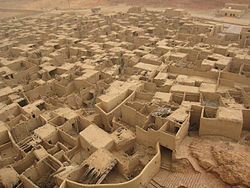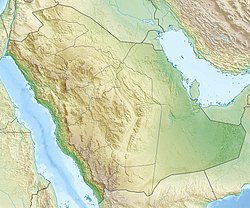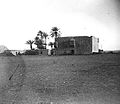Al-'Ula
Al-'Ula
ٱلْعُلَا | |
|---|---|
 | |
 Al-'Ula | |
| Coordinates: 26°37′N 37°55′E / 26.617°N 37.917°ECoordinates: 26°37′N 37°55′E / 26.617°N 37.917°E | |
| Country | |
| Region | Al Madinah |
Al-'Ula[1] (Arabic: ٱلْعُلَا al-ʿulā), is a city of the Medina Region in north-western Saudi Arabia. Historically located on the incense route, the city lies within the Governorate of 'Ula (Arabic: مُحَافَظَة ٱلْعُلَا, romanized: Muḥāfaẓat Al-ʿUlā), one of seven in the Medina Region, covering an area of 29,261 square kilometres (11,298 sq mi). The city is 110 km (68 mi) southwest of Tayma and 300 km (190 mi) north of Medina.[2] The city (municipality) covers 2,391 square kilometres (923 sq mi).[3] The population of the city is 5,426.[3]
Al-'Ula was the capital of the ancient Lihyanites (Dedanites). The governorate contains the first UNESCO World Heritage Site in the Saudi Kingdom, called Hegra (also known as Al-Hijr, or Mada'in Saleh / Mada'in Salih), 22 km (14 mi) north of the city. Hegra (Mada'in Salih) was built more than 2,000 years ago by the Nabataeans. Al-'Ula, the ancient walled city, is packed with mud-brick and stone houses.[4]
History[]
The walled city of Al-'Ula was founded in the 6th century BC, an oasis in the desert valley, with fertile soil and plenty of water. It was located along "Incense Road", the network of routes that facilitated the trading of spices, silk and other luxury items through Arabia, Egypt and India. Al-'Ula stands on the site of the Biblical city of Dedan but was founded with the ancient North Arabian Kingdom of Lihyan, which ruled from the 5th to 2nd century BC.[5] The older history of the oasis has been divided into several phases. The Dedanite kingdom spans the seventh and sixth centuries BC. Dedan is mentioned in the 'Harran Inscriptions'. In these it is told how Nabonidus the king of Babylonia made a military campaign to northern Arabia in 552 BC or somewhat later, conquering Tayma Dedan and Yathrib (Medina).[6] It is thought that around the turn of the fifth century BC the kingdom became hereditary.

The next four hundred years, until around 100 BC, were the time of the Kingdom of Lihyan. The Nabataeans were the lords of the region at least until 106 AD when the Romans conquered their capital Petra. The Nabataeans made Hegra, the modern Mada'in Salih, their second capital. The power centre of the region thus shifted to Hegra some 22 km (14 mi) to the north of Al-'Ula.
Al-Mabiyat some 20 km (12 mi) away near Mughaira became the next commercial centre of the region. It thrived from around 650 until it declined at some time before 1230. In the 13th century the old city of Al-'Ula was built and many stones of the old Dedanite and Lihyanite ruins were reused. Al-'Ula now became the major settlement of the region again until modern times. Between 1901 and 1908 the Ottomans built the Hejaz railway in order to link Damascus to Madinah. The railway had main stations in both Mada'in Salih (Hegra) and Al-'Ula, where a line was built through the western part of Al-Khuraybah, some 12 km (7.5 mi) to the north of the old medieval town, which is believed to be the site of the old Dedanite and Lihyanite town that is still standing there despite being in bad shape.[citation needed]
In the 20th century the new town centre was established beside the old town and eventually the people left the old buildings. The last family is said to have left in 1983, whilst the last service in the old mosque was held in 1985.[7] Both the ruins of the medieval town and the site of the Liyhanite settlement now lie within the limits of the modern town.
The most detailed study of the area was made by the French priests Antonin Jaussen and Raphael Savignac, who visited the area three times, in 1907, 1908 and 1910. They studied the remains at Hegra and Dedan and collected a large number of Lihyanite, Minaean, Thamudic and Nabataean inscriptions. Accordingly, it was their work that came to constitute the basis for all further study and research in the history of the area.[8]
The first European traveller of modern times to describe the town was Charles Doughty in 1876. Charles Huber was in Al-'Ula in 1881–82. He returned in 1883 accompanied by Julius Euting. In 1968 a team of archaeologists from the University of London investigated some fifteen inscriptions.
The vertical sandstone cliffs surrounding the valley provide ample surfaces for rock art, making the governorate one of the richer petroglyph regions in the Kingdom. Ar-Ruzeiqiah is a mountain in the southern part of the governorate, with a large petroglyph panel displaying hundreds of images, including depictions of hunting scenes with humans and a variety of animals. Ibex are the most common species but camels, horses and other species can also be found. Mount Ikma also has a large façade with scenes, strange symbols and inscriptions.[9]
Cities, towns, villages[]
There are four major municipalities in the Governorate of 'Ula: Al-'Ula: the capital lying to the southwest (population 5,426); Mughīrāʾ (Arabic: مُغِيْرَاء) to the southeast (population 8,952); Abu Raku, to the north (population 2,678); and Al Hajar to the northeast (population 1,707).[3]
Heritage Village[]
Al-'Ula Heritage Village, also known as Ad-Deerah, is the traditional Arabian village to which people of the oasis moved some eight centuries ago and inhabited until the 20th century. It was built on a higher part of the valley in order to be clear of the floods that can occur during the rainy season. At its maximum expansion the town contained more than 1000 houses, which were built adjacent to one another, thereby forming a wall around the town to defend the population. On the west of the town, at the bottom of the cliff, is the old souq, which has been renovated.[10]
Timeline[]
Here is the sequence of historical events and the ancient evidence found in the Al-'Ula governorate:[11]
| History | Evidences |
|---|---|
| Bronze Age |
|
| Ancient North Arabian Kingdoms (DEDAN) |
|
| Nabataean Kingdom (Hegra) |
|
| Roman presence |
|
| Islamic period (QURH, Al-'Ula) |
|
| Ottoman presence |
|
Royal Commission for Al-'Ula[]
The importance of Al-'Ula as an archaeological and historic site led to the establishment of The Royal Commission for Al-'Ula (RCU) in July 2017, the aim of which is to develop and promote Al-'Ula as an international tourism destination.[12] Moreover, the commission develops the plans for heritage conservation and preservation.[13]
Development plan[]
To promote tourism and gain more attraction, the Royal Commission on Al-'Ula is training 200 young Saudis on an ambitious project where tourists will explore the area's cultural treasures. Recruited from the Al-'Ula region, the 200 young people (all high-school age or in their first year as university students, and split 50-50 between boys and girls) are in Riyadh, Saudi Arabia being trained in hospitality, learning new languages, studying farming and water technology, and researching the cultural, social and natural history of their home region.[14]
Prince Abdul Majeed bin Abdulaziz Airport[]
The Prince Abdul Majeed bin Abdulaziz International Airport was a crucial part of the development strategy of the Royal Commission for Al-'Ula (RCU), which envisioned making it a global destination for culture and tourism. In March 2021, the airport was approved to receive international flights, along with an increased capacity of receiving 15 commercial flights at a time. Besides, the capacity was tripled, raised from 100,000 to 400,000 passengers per year.[15][16]
Tourism[]
Al-'Ula has the potential to be one of the most important archaeological destinations for tourists from across the world. Saudi Arabia is collaborating with experts from around the world on the Al-'Ula development and in April signed a 10-year deal with France that includes provisions for hotels, transport infrastructure and a world-class culture and art museum.[17]
A major integrated archaeological survey of Al-'Ula valley and beyond has been launched by the commission, charged with protecting and regenerating this north-western region. Until a conservation and development plan can be established, some of the sites including the World Heritage Site of Mada'in Salih are temporarily closed to the public. It will re-open in 2020 for visitors.[18]
Sharaan Resort[]
A resort is planned to be built as early as 2020 and completed in 2023 in Sharaan area. The result will have residential places, a conference venue, a relaxing area and restaurants.[19]
"Winter at Tantora" festival[]
Winter at Tantora was a traditional celebration to mark the start of the 40 day winter growing season. The name of the festival 'Tantora' is inspired by a sundial located in the old town of Al-'Ula, which has been using by the locals as a marker for the changing of the seasons.[20] On 20 December 2018, the first "Winter at Tantora" started with a series of different themed weekend events including music, arts, entertainment, and cultural events. The concerts were performed in Maraya Concert Hall, which was newly constructed for this purpose,[21] and whose external walls are covered with mirrors, "Maraya" being the Arab word for "Mirrors".[22] The second edition of Winter at Tantora Festival starts on 19 December 2019, including performances by Omar Khairat, EBI "Ebrahim hamedi", Andrea Bocelli, Yanni, Enrique Iglesias and Lionel Richie.[23]
On 26 December 2019, Maraya Concert Hall set a Guinness world record for the largest mirrored building in the world, in which it is covered by 9,740 square metres (104,800 sq ft) of mirrored façade.[24]
Persian Night in Saudi Arabia’s Al-'Ula[]
From March 6 to March 7, 2020, a large concert of Iranian singers was held at the winter celebration of the Kingdom of Saudi Arabia in the city of Al-'Ula. Ebi, Leila Forouhar, Shahram Shabpareh, Shadmehr Aghili, Andy (Andranik Madadian), Arash and Sasy were present at the concert.[25]
Al-'Ula vision[]
On 11 February 2019, Saudi Arabia's Crown Prince Mohammed bin Salman launched the Al-'Ula vision which features a resort and nature reserve called Sharaan.[26] The vision also includes the establishment of the Global Fund for the protection and revitalization of the Arabian Leopard.[27]
See also[]
- Sarat Mountains
- Hijaz Mountains
- Hijaz Railway
- The temple of Mahlab al-Naqa
References[]
- ^ "Heritage Sites in Al-'Ula, Saudi Arabia | ExperienceAlUla.com". experiencealula.com. Retrieved 2020-06-03.
- ^ محافظة العلا في السعودية [Al-Ola Governorate in Saudi Arabia]. موسوعة المحيط [The Encyclopedia of the Ocean]. 11 August 2018.
- ^ Jump up to: a b c العلا.. عروس الجبال.. عاصمة الآثار.. مدينة الأربعين عينًا [Al-ʿUla .. Bride of the mountains .. The capital of monuments .. The city of forty Ain]. Al Madina. 1 December 2013. Archived from the original on 13 January 2018. Retrieved 10 May 2019.
- ^ Chowdhury, Arka Roy (16 April 2018). "Saudi Arabia is planning to open the region of Al-'Ula for tourists". The Times of India. Archived from the original on 15 January 2019.
- ^ "Al 'Ula".
- ^ Gadd, C. J. (1958), The Harran Inscriptions of Nabonidus, 8, Anatolian Studies, p. 59
- ^ Modern Al-'Ula Archived 2011-07-23 at the Wayback Machine at Madainsale.net.
- ^ Al-Nasif, Abdallah (1981). "Al-'Ula (Saudi Arabia): A Report on a Historical and Archaeological Survey". Bulletin (British Society for Middle Eastern Studies). 8 (1): 30–32. doi:10.1080/13530198108705304. JSTOR 194675.
- ^ "Al Ula - Arabian Rock Art Heritage".
- ^ "Al-'Ula". Saudi Arabia Tourism Guide. 14 September 2017.
- ^ "RCU". www.rcu.gov.sa.
- ^ "King Salman Appoints Commissions to Develop Al-Ola and Diriyah Gate into Major Tourist Attractions". www.businesswire.com. 2017-07-25. Retrieved 2019-02-11.
- ^ "الهيئة الملكية لمحافظة العلا - Royal Commission for Al-'Ula". twitter.com. Retrieved 2019-02-11.
- ^ "A new era dawns for Saudi Arabia's ancient cities of Al-'Ula". Arab News. 9 April 2018.
- ^ "Al-'Ula Airport Starts Receiving International Flights". Asharq AL-Awsat. Retrieved 5 March 2021.
- ^ "Saudi Arabia to allow international flights to land at Al-'Ula airport - SPA". Reuters. Retrieved 4 March 2021.
- ^ "France to help build a 'new Petra' in Saudi Arabia with estimated $20bn development deal". www.theartnewspaper.com.
- ^ "New drive to showcase the treasures of Saudi Arabia's ancient city of Al-'Ula". Arab News. 3 May 2018.
- ^ "Architect Jean Nouvel talks about design for resort among Al-'Ula's rocks". Arab News. 2019-02-11. Retrieved 2019-02-11.
- ^ "About Al-'Ula". www.winterattantora.com. Archived from the original on 2019-07-30. Retrieved 2019-02-05.
- ^ Nihal, Mariam (2019-01-16). "Winter at Tantora Festival announced in Al-'Ula". Saudigazette. Retrieved 2019-02-05.
- ^ "Saudi Arabia's Maraya Concert Hall: An architectural wonder of the world". Arab News. March 18, 2020.
- ^ "Winter at Tantora Festival: See Al-'Ula's Culture Come to Life". experiencealula.com.
- ^ "Largest mirrored building". Guinness World Records. 26 December 2019.
- ^ "Iranian singers perform at historic 'Persian Night' in Saudi Arabia's al-Ula". english.alarabiya.net. Retrieved 2020-03-06.
- ^ "Launching the Vision for Saudi Arabia's ancient Al-'Ula city". Arab News. 2019-02-10. Retrieved 2019-02-11.
- ^ "'Al Ula Vision... Saudi Arabia gift to world'". Saudigazette. 2019-02-11. Retrieved 2019-02-11.
Further reading[]
- Abdul Rahman Ansary, Ḥusayn Abu Al-Ḥassān, The civilization of two cities: Al-ʻUlā & Madāʼin Sāliḥ, 2001, ISBN 9960-9301-0-6, ISBN 978-9960-9301-0-7
External links[]
![]() Media related to Al-'Ula at Wikimedia Commons
Media related to Al-'Ula at Wikimedia Commons
- Archaeological sites in Saudi Arabia
- History of the Arabian Peninsula
- Populated places in Medina Province (Saudi Arabia)
- Oases of Saudi Arabia

